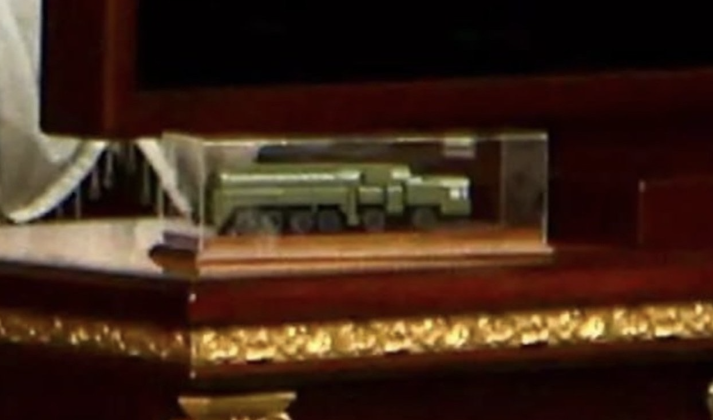News
First Look at Russia’s New Oreshnik Intermediate Range Hypersonic Ballistic Missile Provided By Belarus Footage
A video released by Belarusian state media has reportedly revealed a model of the Russian Oreshnik intermediate range ballistic missile, the appearance of which was previously unknown. Appearing on the desk of Belarusian president Alexander Lukashenko, a large launcher appeared to be mounted on a Belarusian MZKT-79291 chassis with a 12 wheel configuration. The Oreshnik is Russia’s first intermediate range ballistic missile class developed since the Soviet era, and was first fired in combat on November 21 against Ukrainian targets, at which time the program’s existence was first announced to the world. Russian President Vladimir Putin on June 23 confirmed that serial production had begun, and that the missile had performed well in combat testing. Preceding the missile’s introduction into service, Russia’s ability to launch tactical surface-to-surface strikes against targets at medium or intermediate ranges remained highly limited, with targets in Western Europe, Alaska, and Guam being out of reach.

After the new missile class enters service, deployments on the territory of Russia’s sole European ally Belarus are expected to be prioritised, with Secretary of the Russian Security Council Alexander Volfovich confirming on May 29 that such deployments would begin before the end of the year. Conventionally armed variants may be exported to equip the Belarusian Armed Forces, while nuclear armed variants are expected to fall under Belarusian control during wartime as part of the two countries’ nuclear sharing agreement signed in 2023.
The Oreshnik’s combination of range, precision, and advanced penetrative capabilities have raised significant concerns across much of the Western world, with Russian Ambassador to the United Kingdom Andrey Kelin claiming shortly after the missile’s first combat launch that it had had a significant impact on British policy toward Moscow, forcingLondon to take a more cautious approach towards supporting Ukrainian deep strikes against Russian targets. The ability of longer range tactical ballistic missiles to play a central role in determining the outcome of a conflict was demonstrated in June during Iranian-Israeli hostilities, the outcome of which may have further increased the perceived importance of the Oreshnik program.












